Shaolin Kung Fu: A Complete Guide to the Dynamic Art
Martial artists are drawn to Shaolin Kung Fu from all over the world, and it’s no surprise as it has a rich history, a unique set of fighting techniques, and a strong philosophical background. It combines Chinese martial arts techniques with Zen Buddhist philosophy and places great importance on physical and spiritual enlightenment. Although one of the most enticing factors might be its depiction in Chinese martial arts movies and media, let’s explore Shaolin Kung Fu and see if it lives up to its expectations!
History of Shaolin Kung Fu
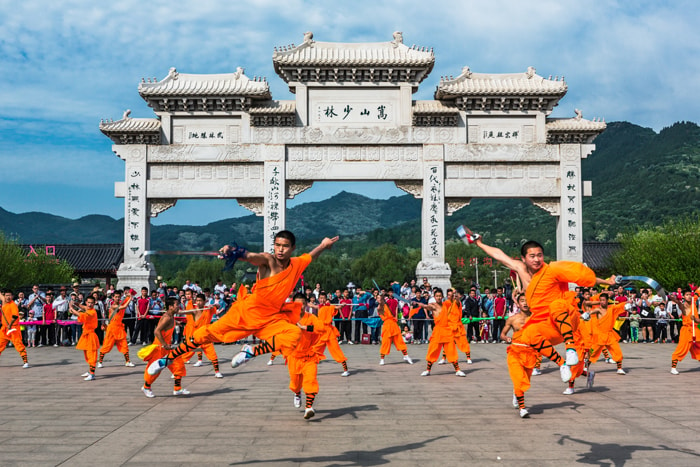
Shaolin Kung Fu is one of the oldest Kung Fu styles, dating back to the Shaolin Monastery in Henan, China, around the 5th century AD. Legends tell the story of an Indian monk named Bodhidharma, who introduced physical training to assist Shaolin monks in meditation.
Bodhidharma traveled to the Shaolin Monastery on a pilgrimage, where he found the monks were weak and unable to sustain long meditation sessions. Chinese monasteries often practiced martial arts to protect their monks. To improve their physical and mental endurance, Bodhidharma taught them a series of techniques inspired by Indian martial arts and yoga, which eventually became the foundation of Shaolin Kung Fu. These exercises aimed to enhance the monks’ health and spiritual focus.
Over time, the monks expanded Bodhidharma’s teachings and integrated Chinese martial arts techniques and philosophies. This led to the development of a comprehensive martial arts system known for its rigorous training, mental discipline, and combat skills. It is believed that the teachings of Bodhidharma were developed into a style of Kung Fu called Chuan Fa, and after many years, it was Chuan Fa that was refined into Shaolin Kung Fu.
The system developed into what is now known as Shaolin Kung Fu. Through the teachings of Bodhidharma and spiritual cultivation, the Shaolin monks developed the martial art that became known as Shaolin kung fu.
This style of Kung Fu gained prominence during the Tang and Song dynasties, evolving through both internal development and external influences. However, Chinese historical records document the existence of martial arts in China for thousands of years.
The Chinese martial art of wrestling, known as Shuai Jiao, predates the establishment of the Shaolin temple by several centuries, and some believe it may have been Shuai Jiao that played a significant role in the development of Shaolin Kung Fu and not the Bodhidharma. No matter which story of origin you choose to believe about Shaolin Kung Fu, the practice is what matters most; the stories simply bring excitement and add cultural elements to the martial art.
Internal and External Kung Fu
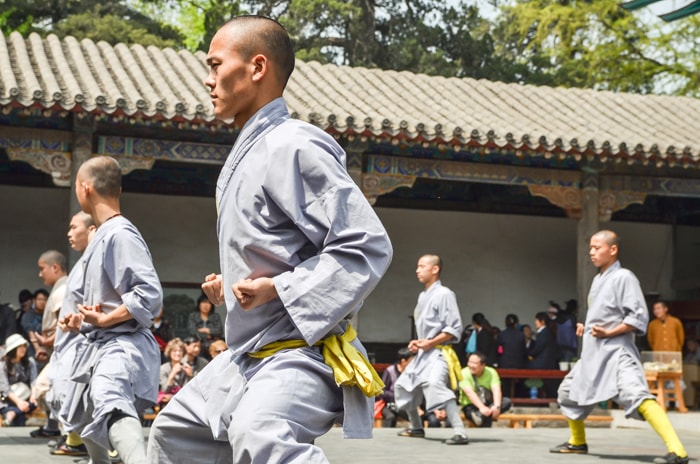
- Huang Zongxi, a renowned Chinese theorist and philosopher, described the Chinese martial arts as internal or external. Neijia is the Chinese term for internal martial arts, which focus on meditative practices and improve the spiritual side of one’s character. Waijia, on the other hand, concentrates on physical practices like forms, exercises, and techniques. Let’s look into the characteristics of both.
Internal Kung Fu (Neijia)
Characteristics:
- Focus on Internal Energy: Emphasizes the cultivation and manipulation of qi (internal energy).
- Softness and Flexibility: Techniques are typically softer, smoother, and involve more flowing movements.
- Mind-Body Connection: Greater emphasis on meditation, breathing techniques, and mental focus.
- Examples: Tai Chi (Taijiquan), Bagua Zhang (Eight Trigram Palm), and Xingyi Quan (Shape-Will Boxing).
Training:
- Qi Gong: Practices to enhance internal energy.
- Slow, Controlled Movements: improve balance, coordination, and internal strength.
- Meditation: To cultivate mental clarity and focus.
External Kung Fu (Waijia)
Characteristics:
- Physical Strength and Agility: Focuses on building muscle strength, speed, and external power.
- Hardness and Force: Techniques are generally more forceful, direct, and explosive.
- Physical Conditioning: Greater emphasis on physical conditioning and endurance.
- Examples: Shaolin Kung Fu, Wing Chun, and Hung Gar.
Training:
- Strength Training: Exercises to enhance muscle power and physical resilience.
- High-Impact Techniques: Kicks, punches, and strikes that rely on physical power.
- Sparring and Forms: Practicing forms (Taolu) and engaging in sparring to develop practical fighting skills.
Shaolin Kung Fu strikes the perfect balance between internal and external martial arts. It promotes both while not neglecting one: the Ying and Yang effect, which has definitely influenced this style of Kung Fu.
Styles and Techniques
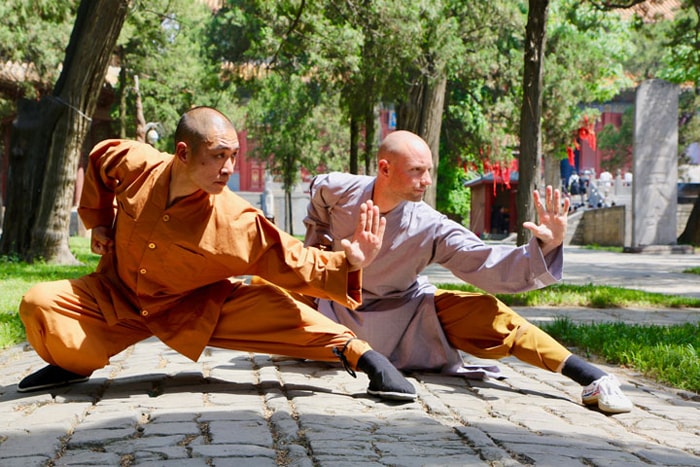
Shaolin styles consist of a variety of animal forms and techniques; these unusual styles reflect their rich and multifaceted heritage. Rooted in the principles of Chan Buddhism, Shaolin Kung Fu includes both powerful and soft techniques, combining physical abilities with mental discipline.
The styles range from the powerful and direct movements of the Tiger Style, which emphasizes strength and aggression, to the fluid and evasive techniques of the Snake Style, which focus on agility and precision. Other notable styles include Crane Style, known for its graceful and balanced movements, and Dragon Style, which integrates both hard and soft elements to achieve versatility.
Techniques in Shaolin Kung Fu often involve a combination of kicks, punches, throws, joint locks, and acrobatic maneuvers. Shaolin Kung Fu also pays close attention to precision timing and perfect technique.
Forms (Taolu)
In Shaolin Kung Fu, taolu (forms) are intricate sequences of movements that represent the traditional background of the techniques. Forms combine strikes, kicks, stances, and defensive techniques to create fluid patterns. Each taolu’s design aims to enhance specific attributes such as strength, flexibility, speed, and internal energy (qi). Taolu practice enables students to internalize fighting strategies while also improving their physical conditioning and coordination.
Forms also preserve the rich heritage of Shaolin martial arts. The forms range from simple, beginner-level routines to complex, advanced sequences, each serving as a step forward in the journey to mastering Shaolin Kung Fu. Here are some of the forms taught in Shaolin Kung Fu:
- Xiao Hong Quan (Small Red Fist)
- Da Hong Quan (Big Red Fist)
- Tong Bei Quan (Through-the-Back Fist)
- Lian Huan Quan (Linked Fist)
- Wu Bu Quan (Five Stances Fist)
- Yi Lu Mai Fu (First Ambush)
- Er Lu Mai Fu (Second Ambush)
- Qixing Quan (Seven Star Fist)
- Luohan Quan (Arhat Fist)
- Mei Hua Quan (Plum Blossom Fist)
- Xiao Luohan Quan (Small Arhat Fist)
- Yi Jin Jing (Muscle-Tendon Change Classic)
- Ba Duan Jin (Eight Pieces of Brocade)
- Rou Quan (Soft Fist)
This list does not include all Shaolin Kung Fu forms, as there are many styles, and some might have different variations and their own unique forms. Correctly performed forms are beautiful and resemble works of art, yet mastering them can be challenging and often requires years of practice.
This is an aspect of Shaolin Kung Fu that is intriguing for some and tedious for others. The key to learning forms is to try and understand the mechanisms behind them, rather than just going through the motions. By understanding the purpose of the form, it will naturally become more interesting to learn.
Weapons Training
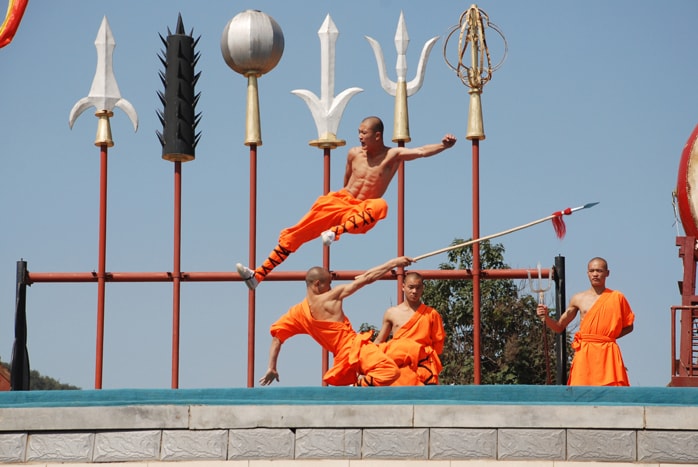
Shaolin Kung Fu frequently practices weapons training with a variety of weapons. Practitioners often become experts at wielding traditional Chinese weapons after years of practice. These are some commonly practiced weapons used in Shaolin Kung Fu.
- Staff (Gun)
- Broadsword (Dao)
- Straight Sword (Jian)
- Spear (Qiang)
- Chain Whip (Bian)
- Hook Swords (Shuang Gou)
- Monk’s Spade (Yue Ya Chan)
- Meteor Hammer (Liu Xing Chui)
- Double Daggers (Shuang Dao)
- Three-Section Staff (San Jie Gun)
- Nine-Section Whip (Jiu Jie Bian)
- Wind and Fire Wheels (Feng Huo Lun)
- Butterfly Swords (Hu Die Shuang Dao)
- Iron Ruler (Tie Chi)
- Deer Horn Knives (Lu Jiao Dao)
Most Shaolin Kung Fu schools will teach the use of some, if not all, of these weapons. Along with acrobatic techniques, weapon wielding is one of the most spectacular performances in any martial art.
Training and Practice
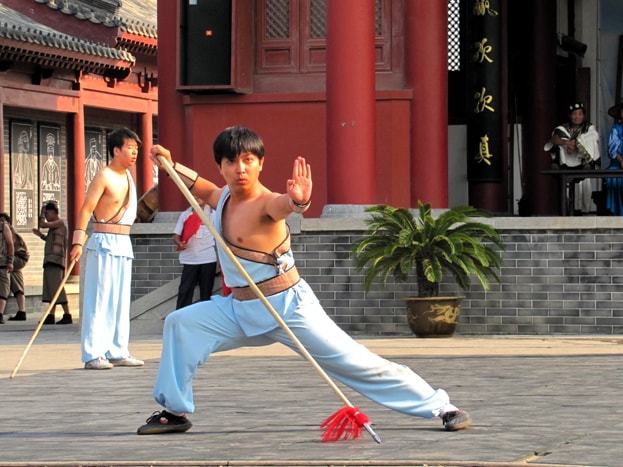
Learning Shaolin Kung Fu in China
Learning Shaolin Kung Fu in China can be a once-in-a lifetime experience, as you are able to learn from some of the best Kung Fu masters in the world. The Shaolin Temple in Henan Province is the most renowned place for studying this ancient martial art. It dates back to 495 AD and carries its ancient traditions into modern society.
The temple allows students to enroll in intensive training programs that cover various aspects of Shaolin Kung Fu, including hand-to-hand combat, weapons training, forms (taolu), and conditioning exercises. Training at the Shaolin Temple or affiliated schools often involves intense physical conditioning and mental discipline, and of course, you will need to present yourself with a willingness to learn.
Many schools offer programs tailored to international students, providing instruction in English and integrating cultural experiences like calligraphy, Mandarin language lessons, and traditional Chinese medicine. The training environment is often austere, focusing on discipline, respect, and dedication. Living in the Shaolin Temple or nearby facilities allows students to experience the daily life of Shaolin monks, including meditation and participation in temple activities, providing a holistic approach to learning Shaolin Kung Fu.
The main benefits of traveling to China to learn Shaolin martial arts are:
- Studying Kung Fu under professional masters with authentic connections to the Shaolin Temple in China.
- Learn Shaolin Kung Fu styles like Praying Mantis Fists, Tai Chi, Qigong, Sanda, Bagua, Xingyi, and Baji Quan from experienced masters.
- Gain cultural experience from local Kung Fu masters at the place of origin.
Learn Shaolin Kung Fu at a Local Academy
Shaolin Kung Fu has become very popular in recent years. It has gained international recognition, which means if you live in a major city, there is likely a suitable Shaolin Kung Fu school nearby. Look out for a favorable training environment and a master who is willing to help beginners on their journey. Many Shaolin Kung Fu schools offer trial lessons, so this is a good way to get an understanding of the martial art and see if you fit in at the academy.
Online Resources and Training for Shaolin Kung Fu
If you do not have the resources or the time to study traditional Shaolin Kung Fu in China, don’t worry; there are some great alternatives. There are many authentic Shaolin Kung Fu masters who are willing to train students online. Shaolin Kung Fu training online is more flexible and convenient for those with busy schedules. It might not be the complete package, like traveling to China and learning from the best instructors, but it’s a start on a Kung Fu journey that could lead you to the Shaolin Temple one day.
Shaolin Martial Arts in Modern Times
Chinese martial arts have had a great influence on Japanese martial arts, as many Japanese karate practitioners once traveled to China to learn more from Kung Fu masters. Some lineages of karate have traditions that claim Shaolin origins, and it is easy to see the influence of Chinese martial arts in the techniques used in karate.
Martial arts traditions in Japan, Korea, Sri Lanka, and certain Southeast Asian countries also cite Chinese influence as transmitted by Buddhist monks.
Summary
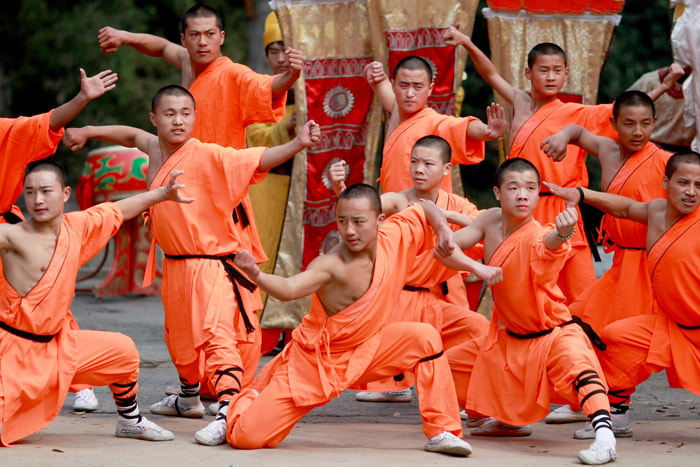
Shaolin Kung Fu offers a comprehensive training regiment that very few martial arts have. This includes weapons training, self-defense techniques, traditional forms, and mediation. This complete array of techniques and practices is an important part of Chinese martial arts that continues to inspire new students worldwide. With its rich history and unique styles, Shaolin Kung Fu looks like it will remain a major player in the martial arts world.









